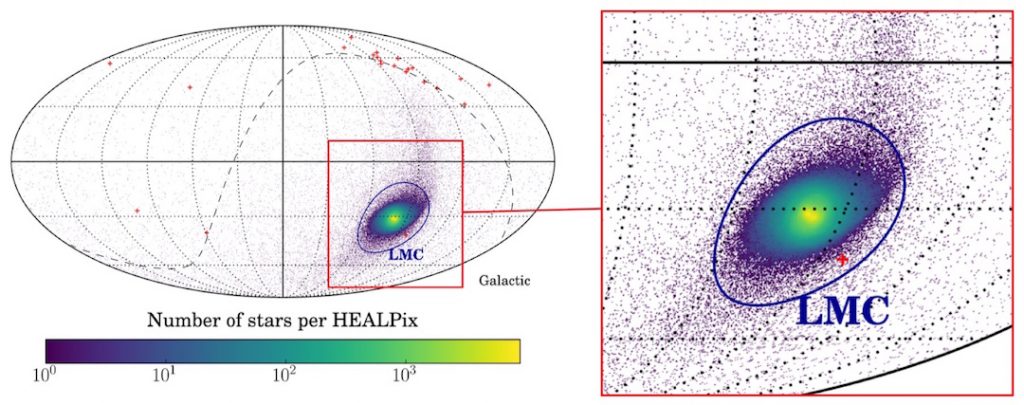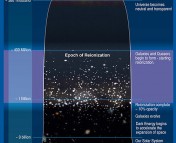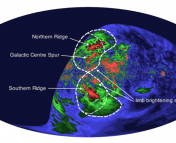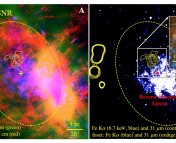Title: Hypervelocity runaways from the Large Magellanic Cloud
Authors: D. Boubert, D. Erkal, N.W. Evans, R.G. Izzard
First Author’s Institution: Institute of Astronomy, University of Cambridge
Status: Published in MNRAS, open access
The fastest known stars in the Galaxy are the ones orbiting the supermassive black hole in its very center. At the time of closest approach to the black hole, these stars can reach speeds on the order of 10000 km/s or more. Their origin is suspected to be the Hills mechanism: If a binary star system is scattered into the vicinity of the black hole, by gravitational interaction one of the companion stars can get captured on a close orbit, while the other is ejected.
A few extremely fast-moving stars have also been discovered in the Galactic halo, traveling at speeds exceeding 500 km/s, some of which could even escape the Milky Way. Presumably, these hypervelocity stars are the Hills stars now outbound from the Galactic center, although alternative explanations have been proposed as well. The authors of today’s paper explore yet another scenario: Could the Milky Way’s hypervelocity stars originate from the Large Magellanic Cloud (LMC)?
To answer this question, the authors first generate a synthetic population of stars, accounting for the specific star formation history of the LMC, while giving special attention to modeling the evolution of stellar binaries. They then identify potential runaway stars that are ejected from binary systems after supernova explosions. These stars (or stellar remnants) can receive kicks up to several 100 km/s, in particular if a supernova occurs in a previously close, interacting massive binary system. This can happen in the Milky Way too, but because the LMC is significantly less massive, less extreme kicks are enough to accelerate stars to escape velocity.
As a next step, the identified runaway stars are placed in a joint, large-scale dynamical simulation of the LMC and Milky Way. Performing this simulation makes it possible to find out which stars could end up in which present-day locations and with what velocities. Finally, the authors compute the observable properties of all stars in their simulation, to check the feasibility of detecting a population of LMC runaways in current or future surveys.

Figure 1: The expected on-sky distribution of LMC runaway stars at the present day. Most of them have evolved into stellar remnants, but still thousands of main-sequence stars could have survived. The known hypervelocity stars are marked by red crosses, but the area below the dashed line in particular has not yet been thoroughly searched for more. An animated version of this figure is available at https://youtu.be/eE-1JXBP1J8. (Figure 2 from the paper, with the dashed line added to indicate the celestial equator.)
The population of LMC runaways they predict is consistent with several recent observations. Firstly, the brightest stars in the LMC, which are massive stars most likely to either have a companion or to be runaway stars, show motions that are generally matching expectations. Secondly, there exist young stars in the outskirts of the LMC, far away from regions of star formation. Thirdly, an unusually large fraction of massive main-sequence stars formed in the leading arm of the LMC appear to be single stars.
But could the Milky Way’s hypervelocity stars actually be LMC runaways? The authors call it a realistic possibility. They estimate that tens of thousands of stars have escaped the LMC over the last 2 Gyr in total and that thousands of them could have survived as observable, main-sequence stars until today. Many of them could also escape the Milky Way and would be classified as hypervelocity stars.
The latest, most extensive searches for hypervelocity stars have unfortunately not yet had a chance of finding the the majority of hypervelocity runaways from the LMC, because of missing sky coverage in the Sloan Digital Sky Survey (SDSS). But the few hypervelocity stars that have been found so far are clustered in a region of the sky that extends along the projected path of the LMC, where detections of LMC runaway stars would be anticipated, and they have velocities and distances compatible with an LMC origin (Figure 1).
However, the known hypervelocity stars are somewhat more massive than the predicted runaways (more than three solar masses). This discrepancy with respect to observations could be resolved, if the assumptions going into the adopted binary evolution model were to change. Most importantly, it would be necessary to adjust or better constrain the parameters describing the common envelope phase, much about which is still unknown.
The authors conclude that at least some LMC runaway stars, being unavoidable by-products of normal star formation, must classify as Milky Way hypervelocity stars. If the Gaia mission can help discover more than only a few runaway stars escaping the LMC, hypervelocity stars will remain special but maybe not as rare as they seem now, and we can look forward to getting a much better opportunity of understanding all their various possible origins.





Trackbacks/Pingbacks